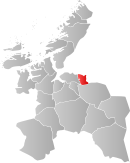Malvik
| Malvik kommune | |||
|---|---|---|---|
| Municipality | |||

View of Muruvik in Malvik
|
|||
|
|||
 Malvik within Sør-Trøndelag |
|||
| Coordinates: 63°22′22″N 10°45′3″E / 63.37278°N 10.75083°ECoordinates: 63°22′22″N 10°45′3″E / 63.37278°N 10.75083°E | |||
| Country | Norway | ||
| County | Sør-Trøndelag | ||
| District | Trondheim Region | ||
| Administrative centre | Hommelvik | ||
| Government | |||
| • Mayor (2015) | Ingrid Aune (Ap) | ||
| Area | |||
| • Total | 168.54 km2 (65.07 sq mi) | ||
| • Land | 162.00 km2 (62.55 sq mi) | ||
| • Water | 6.54 km2 (2.53 sq mi) | ||
| Area rank | 350 in Norway | ||
| Population (2010) | |||
| • Total | 12,550 | ||
| • Rank | 91 in Norway | ||
| • Density | 77.5/km2 (201/sq mi) | ||
| • Change (10 years) | 12.7 % | ||
| Demonym(s) | Malvikbygg | ||
| Time zone | CET (UTC+1) | ||
| • Summer (DST) | CEST (UTC+2) | ||
| ISO 3166 code | NO-1663 | ||
| Official language form | Trøndersk | ||
| Website | www |
||
|
|
|||
Malvik is a village and a municipality in Sør-Trøndelag county, Norway. It is part of the Trondheim Region. The administrative center of the municipality is the village of Hommelvik. Other villages in Malvik include Muruvika, Smiskaret, Sneisen, Vikhammer, and Hundhammeren.
While "Malvik" refers to the municipality as a whole, it also refers to the village of Malvik. Situated between Hommelvik and Vikhammer, this village is the original centre of the municipality, and is where the historic Malvik Church is located. The urban area of the municipality is 3.02 square kilometres (1.17 sq mi) and it has a population of 6,554. The population density is 2,170 inhabitants per square kilometre (5,600/sq mi).
The municipality of Malvik was established in 1891 when it was separated from Strinda. On 1 January 1914, a small area of Lånke (population: 38) was transferred to Malvik. On 1 July 1953, a small area of Malvik (population: 37) was transferred to Strinda.
The municipality (originally the parish) is named after the old Malvik farm (Old Norse: Manvík), since the first church was built there. The first element is probably the word mǫn (stem form man-) which means "mane", referring to a mountain ridge behind the farm. (Mana which means "the mane" is a common name for many mountains in Norway, where the form of the mountain is compared with the mane of a horse.) The last element (Old Norse: Vík) is identical with the word vik which means "inlet".
...
Wikipedia


